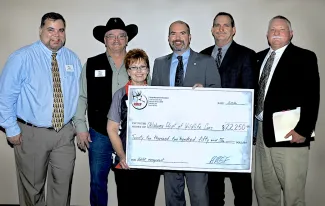
Gathered to present a $22,250 donation from the Rocky Mountain Elk Foundation are, from left, RMEF Regional Director Shane Stenquist, RMEF Regional Chairman Jeff Steele, RMEF State Chairwoman Gayle Steele, Director J.D. Strong... (DON P. BROWN / ODWC)
A list of annual rule changes and additions was approved unanimously Monday by the Oklahoma Wildlife Conservation Commission during its regular meeting in Oklahoma City.
These changes and additions to Title 800, the rules that govern operations of the Oklahoma Department of Wildlife Conservation, were proposed in December and went through a public comment period in January. They will now be sent to the State Legislature and the governor for approval and, if approved, they will become effective later this year.
Among the notable rule changes and additions are:
- Allow deer hunters, without carrying any method of take, to use a leashed dog to recover downed deer, provided the hunter has notified a game warden before using the dog to track the downed deer.
- Add rules, regulations, and definitions for the new Oklahoma Land Access Program (OLAP) including exemption from written permission for hunting antelope and elk on actively enrolled OLAP properties.
- Add rules to allow landowners and their designee to shoot feral hogs at night on their property. This feral hog rule is currently in effect in emergency status.
- Close waters in the northeastern part of the state to snagging from 10 p.m. to 6 a.m., except for the Neosho River snagging area at Miami City Park.
- Prohibit the stocking of any aquatic organisms into public waters of the state without permission from the Wildlife Department.
In other business, Commissioners accepted a donation of $22,250 from theRocky Mountain Elk Foundation for habitat management activities at Cookson and Cherokee wildlife management areas. The money was raised in Oklahoma, and RMEF Regional Director Shane Stenquist said he was thrilled to be able to put local money back on the ground in Oklahoma to benefit elk.
Also, Paddlefish/Caviar Coordinator Brandon Brown provided an update about research and management of the state’s paddlefish resource. He said those aspects of the Department’s paddlefish program are often overlooked and get little attention, but those areas are where the real benefits are being realized.
Brown said the paddlefish harvest has been steady the past three years, with about 2,500 fish being processed at the Paddlefish Research Center near Miami in each of those years. Data collected while processing these fish allows biologists to create the best strategies to conserve paddlefish. And those strategies are having positive effects.
A“We are setting the bar in paddlefish management,” he said. Oklahoma’s population is naturally reproducing, whereas other states must stock fish to maintain populations. Oklahoma’s paddlefish are also expanding their range in state waters, unlike in other parts of the country. Netting surveys in the past year have shown a remarkable number of smaller paddlefish in state waters, so biologists are expecting a surge in fish numbers in the coming years.
In contrast, the world caviar market has declined because of overproduction of sturgeon caviar in foreign markets. Therefore, the Department’s revenue from caviar sales, which is used to fund conservation and research activities, has declined in the past year.
Also during Monday’s meeting, Commissioners:
- Learned about bills that have been proposed by lawmakers this session in the State Legislature that could have an affect on the Wildlife Department. More than 30 bills dealing with wildlife issues have been filed, but about half of those are shell bills. Director J.D. Strong reminded Commissioners that historically less than 20 percent of bills filed ever make it to the Governor’s desk.
- Met in executive session to discuss the possible purchase of land in Okfuskee County. Commissioner’s authorized Strong and Wildlife Chief Alan Peoples to pursue the purchase.
The Oklahoma Wildlife Conservation Commission is the eight-member governing board of the Oklahoma Department of Wildlife Conservation. The Commission establishes state hunting and fishing regulations, sets policy for the Wildlife Department and indirectly oversees all state fish and wildlife conservation activities. Commission members are appointed by the governor and confirmed by the Oklahoma Senate.
The next scheduled Commission meeting will begin at 9 a.m. Monday, March 6, 2017, at the Wildlife Department’s temporary headquarters, 2145 NE 36th St. in Oklahoma City.